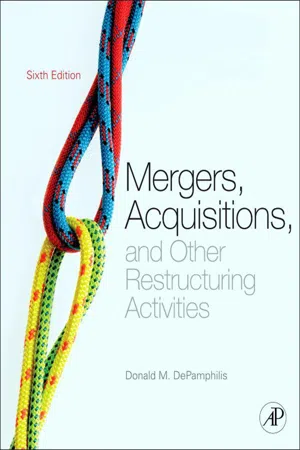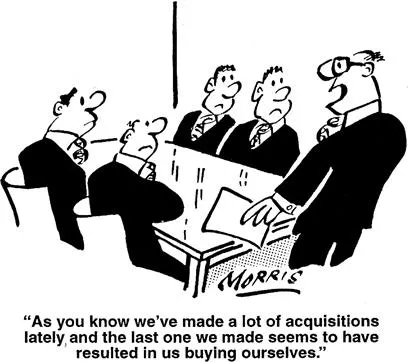![]()
PART I
The Mergers and Acquisitions Environment
Introduction
Chapter 1 Introduction to Mergers and Acquisitions
Chapter 2 Regulatory Considerations
Chapter 3 The Corporate Takeover Market
![]()
Introduction
Courtesy of www.CartoonStock.com
Part I discusses the context in which mergers, acquisitions, and corporate restructuring occur, including factors often beyond the control of the participants in the M&A process. Chapter 1 provides an overview of mergers and acquisitions by discussing basic vocabulary, the most common reasons why M&As happen, how such transactions occur in a series of somewhat predictable waves, and participants in the M&A process, from investment bankers to lenders to regulatory authorities.
The chapter also addresses whether M&As benefit shareholders, bondholders, and society, with conclusions based on recent empirical studies. The labyrinth of regulations that impact the M&A process is addressed in Chapter 2, including U.S. federal and state securities and antitrust laws, as well as environmental, labor, and benefit laws that add to the increasing complexity of such transactions. The implications of cross-border transactions, which offer an entirely new set of regulatory challenges, also are explored. Viewed in the context of a market in which control transfers from sellers to buyers, Chapter 3 addresses common takeover tactics employed as part of an overall bidding strategy, the motivation behind such tactics, and the defenses used by target firms to deter or delay such tactics. Bidding strategies are discussed for both friendly and unwanted or hostile business takeovers. In hostile transactions, the corporate takeover is viewed as a means of disciplining underperforming management, improving corporate governance practices, and reallocating assets to those who can use them more effectively.
The reader is encouraged to read about transactions currently in the news and to identify the takeover tactics and defenses employed by the parties to the transactions. One's understanding of the material can be enriched by attempting to discern the intentions of both the acquiring and target firms' boards and management and thinking about what you might have done differently to achieve similar goals.
![]()
Chapter 1
Introduction to Mergers and Acquisitions
If you give a man a fish, you feed him for a day. If you teach a man to fish, you feed him for a lifetime.
—Lao Tze
Inside M&A: dell moves into information technology services
Dell Computer's growing dependence on the sale of personal computers and peripherals left it vulnerable to economic downturns. Profits had dropped more than 22% since the start of the global recession in early 2008 as business spending on information technology was cut sharply. Dell dropped from number 1 to number 3 in terms of market share, as measured by personal computer unit sales, behind lower-cost rivals Hewlett-Packard and Acer. Major competitors such as IBM and Hewlett-Packard were less vulnerable to economic downturns because they derived a larger percentage of their sales from delivering services.
Historically, Dell has grown “organically” by reinvesting in its own operations and through partnerships targeting specific products or market segments. However, in recent years, Dell attempted to “supercharge” its lagging growth through targeted acquisitions of new technologies. Since 2007, Dell has made ten comparatively small acquisitions (eight in the United States), purchased stakes in four firms, and divested two companies. The largest previous acquisition for Dell was the purchase of EqualLogic for $1.4 billion in 2007.
The recession underscored what Dell had known for some time. The firm had long considered diversifying its revenue base from the more cyclical PC and peripherals business into the more stable and less commodity-like computer services business. In 2007, Dell was in discussions about a merger with Perot Systems, a leading provider of information technology (IT) services, but an agreement could not be reached.
Dell's global commercial customer base spans large corporations, government agencies, healthcare providers, educational institutions, and small and medium firms. The firm's current capabilities include expertise in infrastructure consulting and software services, providing network-based services, and data storage hardware; nevertheless, it was still largely a manufacturer of PCs and peripheral products.
In contrast, Perot Systems offers applications development, systems integration, and strategic consulting services through its operations in the United States and ten other countries. In addition, it provides a variety of business process outsourcing services, including claims processing and call center operations. Perot's primary markets are healthcare, government, and other commercial segments. About one-half of Perot's revenue comes from the healthcare market, which is expected to benefit from the $30 billion the U.S. government has committed to spending on information technology (IT) upgrades over the next five years.
In 2008, Hewlett-Packard (HP) paid $13.9 billion for computer services behemoth EDS in an attempt to become a “total IT solutions” provider for its customers. This event, coupled with a very attractive offer price, revived merger discussions with Perot Systems. On September 21, 2009, Dell announced that an agreement had been reached to acquire Perot Systems in an all-cash offer for $30 a share in a deal valued at $3.9 billion. The tender offer (i.e., takeover bid) for all of Perot Systems' outstanding shares of Class A common stock was initiated in early November and completed on November 19, 2009, with Dell receiving more than 90% of Perot's outstanding shares.
Chapter overview
In this chapter, you will gain an understanding of the underlying dynamics of mergers and acquisitions (M&As) in the context of an increasingly interconnected world. The chapter begins with a discussion of why M&As act as change agents in the context of corporate restructuring. Although other aspects of corporate restructuring are discussed elsewhere in the chapter, the focus here is on M&As, why they happen, and why they tend to cluster in waves. You will also be introduced to a variety of legal structures and strategies that are employed to restructure corporations. Moreover, the role of the various participants in the M&A process is explained. Using the results of the latest empirical studies, the chapter addresses questions of whether mergers pay off for the target and acquiring company shareholders and bondholders, as well as for society. Finally, the most commonly cited reasons for why some M&As fail to meet expectations are discussed.
Throughout this book, a firm that attempts to acquire or merge with another company is called an acquiring company, acquirer, or bidder. The target company or target is the firm being solicited by the acquiring company. Takeovers or buyouts are generic terms for a change in the controlling ownership interest of a corporation. A review of this chapter (including practice questions and answers) is available in the file folder entitled Student Study Guide on the companion site for this book (www.elsevierdirect.com/companions/9780123854858). The site also contains a Learning Interactions Library that gives students the opportunity to test their knowledge of this chapter in a “real-time” environment.
Mergers and Acquisitions as Change Agents
Businesses come and go in a continuing churn, perhaps best illustrated by the ever-changing composition of the so-called “Fortune 500”—the 500 largest U.S. corporations. Only 70 of the firms on the original 1955 list of 500 are on today's list, and some 2,000 firms have appeared on it at one time or another. Most have dropped off as a result of merger, acquisition, bankruptcy, downsizing, or some other form of corporate restructuring. Consider a few examples: Chrysler, Bethlehem Steel, Scott Paper, Zenith, Rubbermaid, and Warner Lambert.
The popular media tends to use the term corporate restructuring to describe actions taken to expand or contract a firm's basic operations or fundamentally change its asset or financial structure. Corporate restructuring runs the gamut from reorganizing business units to takeovers and joint ventures to divestitures and spin-offs and equity carve-outs. Consequently, virtually all of the material covered in this book can be viewed as part of the corporate restructuring process. While the focus in this chapter is on corporate restructuring involving mergers and acquisitions, non-M&A corporate restructuring is discussed in more detail elsewhere in this book.
Why Mergers and Acquisitions Happen
The reasons M&As occur are numerous, and the importance of factors giving rise to M&A activity varies over time. Table 1.1 lists some of the more prominent theories about why M&As happen. Each theory is discussed in greater detail in the remainder of this section.
Table 1.1. Common Theories of What Causes Mergers and Acquisitions
| Theory | Motivation |
| OPERATING SYNERGY | |
• Economies of Scale • Economies of Scope | Improve operating efficiency through economies of scale or scope by acquiring a customer, supplier, or competitor |
| FINANCIAL SYNERGY | LOWER COST OF CAPITAL |
Diversification • New Products/Current Markets • New Products/New Markets • Current Products/New Markets | Position the firm in higher-growth products or markets |
Strategic Realignment • Technological Change • Regulatory and Political Change | Acquire capabilities to adapt more rapidly to environmental changes than could be achieved if the capabilities were developed internally |
| Hubris (Managerial Pride) | Acquirers believe their valuation of the target is more accurate than the market's, causing them to overpay by overestimating synergy |
| Buying Undervalued Assets (q-Ratio) | Acquire assets more cheaply when the equity of existing companies is less than the cost of buying or building the assets |
| Mismanagement (Agency Problems) | Replace managers not acting in the best interests of the owners |
| Managerialism | Increase the size of a company to increase the power and pay of the managers |
| Tax Considerations | Obtain unused net operating losses and tax credits, asset write-ups, and substitute capital gains for ordinary income |
| Market Power | Increase market share to improve ability to set prices above competitive levels |
| Misvaluation | Investor overvaluation of acquirer's stock encourages M&As |
Synergy
Synergy is the rather simplistic notion that the combination of two businesses creates greater shareholder value than if they are operated separately. The two basic types of synergy are operating and financial.
Operating Synergy
Operating synergy consists of both economies of scale and economies of scope, which can be important determinants of shareholder wealth creation.1 Gains in efficiency can come from either factor and from improved managerial practices.
Economies of scale refer to the spreading of fixed costs over increasing production levels. Scale is defined by such fixed costs as depreciation of equipment and amortization of capitalized software, normal maintenance spending, and obligations such as interest expense, lease payments, long-term union, customer, and vendor contracts, and taxes. These costs are fixed in t...

